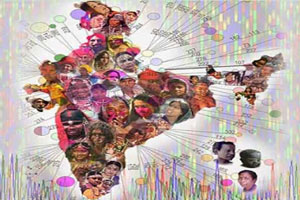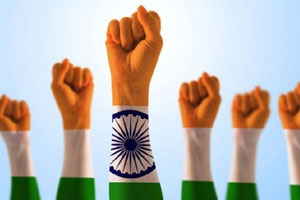
Travelling through the time machine is real fun. Having travelled almost 200 years back , it seems that the Nation that was born on 15 August 1947 was a Nation that came out of immense struggle, not only against external enemies but also against many inimical and divisive forces within.
As Manmohan Singh had once remarked, ‘the crown of British empire was one of the poorest nations of the world’, It was truly a weak, poor and deprived Nation which was at war from within, where millions were displaced and faced unprecedented violence.
Thence, in 1947 the Government inherited a poor, deprived, and a largely illiterate India (almost 88% were illiterate). It hardly had any industry, a scarce road network and public transport system, inadequate medical infrastructure, millions of refugees and a society which had just witnessed genocide.
Comparison
It is interesting to compare the two Indias; one that was born in 1947 and the one that we now live in to comprehend what our parents and grand parents inherited:
|
|
Independent India inherited in 1947/1950 |
India in 2014 -2020 |
Remarks |
|
Roads |
3,99,000 kms |
56 lakh kms |
In 1950 India had 19,811 km of National highways and in 2014 We had 1 lakh kms. |
|
Electricity |
1,362 MW |
3,83,000 MW |
In 1950s only 9Lac homes could be provided power and now India is the Third largest producer of electric power. |
|
Engineering Colleges |
28 |
4,500 |
India now has a largest pool of science graduates. |
|
Cement |
2 million tons capacity and 19 plants |
540 million tons capacity and 250 manufacturing plants |
|
|
Steel |
2 plants and only 1.1 million tonnes manufacturing capacity |
1150 plants. India is the world’s second largest steel producer with a manufacturing capacity of 112 million tons. |
|
|
Research Facilities |
We had few scientists and barely any established Research institutions to carry out research work. |
Now we have almost 162 Research Institutes ranging from Mining to Space. |
Most of these Research facilities have been conceptualized, built and developed after 15 Aug 1947 in last 74 years due to the foresight and vision of our founding fathers.. |
|
Agriculture |
50 million tonnes of food grains in 1947 |
251 million tonnes |
In the last great famine experienced in 1943, two million people died in Bengal. In contrast, in the 1965 famine of Bihar there were no starvation related deaths. India has since then not experienced a famine of that magnitude again. |
|
Poverty |
80% population was poor at the time of independence |
Now it is 22% |
|
|
GDP |
Approx USD21,231 million |
USD2,039,130 million |
The Indian economy is the fifth largest in the world measured by nominal GDP and the third largest by purchasing power parity (PPP). Although we are still pretty behind as far as per capita income is concerned. |
So, a mere look at the Table above, would reveal that back in 1947-50s, India had barely any resources to meet the needs of its people. It had little cement and steel to build dams and rail network, and provide electric power. So it is not surprising that Gandhiji once remarked in 1930s, “The foreign system under which India is governed to-day, has reduced India to pauperism.’”
It was this poor India that our grandparents and parents lived in, which had to import everything, even a pin. From that brink, India was built and has now become strong and self-reliant. We live in an India which is bestowed with many such facilities that our parents could never think of. We live on a sturdier foundation than what was inherited by our parents and grandparents in 1947. It will not be wrong to state that our grandparents and parents laid this foundation. The coming generations can now take the process ahead and build a strong edifice on this strong base.
Besides the above, the leadership then had inherited an India which had lost its political freedom almost 800 years ago and it took a colossal effort to get each part of it united through lot of cajoling, coercing, agreements and rewards. There were also many inherent divisive trends/views based on caste, religion, region, language, and ethnicity. Black flags were raised in Tamil Nadu by the followers of Periyar on the eve of independence. The Premier of Madras Presidency, Omandur Ramaswamy Reddiar who was originally sworn in as Prime Minister of Madras Presidency, had his title changed so India didn’t have two Prime Ministers on Independence Day. Both Nagaland and Kashmir wanted independence. In 1940, the first call for Khalistan was made in a pamphlet titled ‘Khalistan’. As soon as India got freedom a number of insurgent organisations seeking the creation of an independent state in the northeast sprung up.
Grand Vision or Being Pragmatic
In 1955, the Army Chief Rajendrasinghji Jadeja issued directions to the troops fighting insurgency in the northeast:
“You must remember that all the people in which you are operating are fellow-Indians... and the very fact that they are different and yet part of India is a reflection of India’s greatness. Some of these people are misguided and have taken to arms against their own people, and are disrupting the peace in this area. You are to protect the mass of the people from these disruptive elements. You are not there to fight the people in the area, but to protect them. You are fighting only those who threaten the people and who are a danger to the lives and properties of the people. You must therefore, do everything possible to win their confidence and respect and to help them feel that they belong to India.”
It is this spirit of oneness, of unity and of wining hearts of the people that has kept us united despite all the inherent divisive tendencies. In last 70 years we have seen Pakistan breaking up, Myanmar for the most part under military rule, the mighty USSR disintegrating and numerous East European countries like Yugoslavia and Czechoslovakia breaking up.
Our founding fathers had decided that in such a diverse country all aspirations needed to be heard and accommodated. Thus, in 1947 India chose to be a full democracy and a nation of equals, with all the implicit pitfalls. After this long journey of 74 years there is no doubt that we have probably done better than many. Yes we might have been slow, but what is better than being United, being Optimistic and Progressing.
After experiencing turmoil, pain and suffering through these years, this old Hindi song truly expresses the sentiments of the our erstwhile Leaders, our grandparents and parents who underwent that agony and got us out of that dark tunnel:
“Hum laaye Hain Toofan sey Kishti Nikaal key Is desh ko rakhna merey bacchon sambhaal key.”
Many today might not be able to comprehend those sentiments expressed in the song as they love to criticize and point out mistakes of erstwhile leaders, parents and grand parents but surely there are millions who respect those sentiments, are kind and understand the unimaginable task the erstwhile leaders had accomplished and will make sure that their hardwork and scarifice will not go waste.
Jai Hind !

Author. Col N Bhatnagar is an alumnus of NDA, Prestigious Def Services Staff College and XLRI. He served in Indian army as an Infantry Officer in all parts of the country and also in Srilanka and has also worked with Reputed Companies - Power, Hospitality and Health Care sector . He has also worked as a National Assesssor of CII for its CII-EXIM Bank Award and HR Excellence award. He has also authored Three Books.
Disclaimer. The views expressed are of Author.
